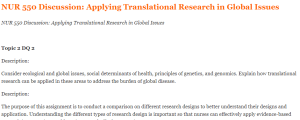NUR 550 Discussion: Applying Translational Research in Global Issues
Sample Answer for NUR 550 Discussion: Applying Translational Research in Global Issues Included After Question
Topic 2 DQ 2
Description:
Consider ecological and global issues, social determinants of health, principles of genetics, and genomics. Explain how translational research can be applied in these areas to address the burden of global disease.
A Sample Answer For the Assignment: NUR 550 Discussion: Applying Translational Research in Global Issues
Title: NUR 550 Discussion: Applying Translational Research in Global Issues
Because chronic disease is the most costly and preventable in the United States, the US Department of Health and Human Services (HHS) created academic research centers that “…conduct community based applied public health research to address chronic disease…causes of death and disability in the United State” (CDC, 2022).
Healthcare is slowly shifting from a proactive to a more reactive stance when it comes to public health. Insurances are now mandated to cover more preventative services than in the past. Currently, there is an array of screenings they must provide, some of which include some cancer screenings, diet counseling, and alcohol misuse screenings, among many others (Preventative, n.d.). Part of those screenings include genomics; “Genomics plays a role in 9 out of 10 leading causes of death…” (Genomics, 2022). Multidisciplinary research in ecological and global issues, and social determinants is key to establishing which diseases are more prevalent in the communities and which need to be addressed. But traditional research takes year to reach application, therefore it is no longer the only or the most effective way to address public health; translational research is helping bridge that gap between research and application.
Translations research, also known as implementation science, tests implementation interventions as well as clarify “…what implementations work for whom” (Titler, 2018). The wait time between evidence-based research and application contributes to poor health outcomes; translational research integrates evidence-based research into practice to improve health care delivery and improve the burden of global disease (Titler, 2018).
References
Centers for Disease Control and Prevention. (2022, November 10). Prevention Research Centers. Centers for Disease Control and Prevention. Retrieved January 29, 2023, from https://www.cdc.gov/prc/
Genomics.Healthy People 2020. (2022). Retrieved January 29, 2023, from https://wayback.archive-it.org/5774/20220413202808/https://www.healthypeople.gov/2020/topics-objectives/topic/genomics
Preventive care benefits for adults. HealthCare.gov. (n.d.). Retrieved January 29, 2023, from https://www.healthcare.gov/preventive-care-adults/
Titler, M. G. (2018). Translation Research in Practice: An Introduction. Online Journal of Issues in Nursing, 23(2), 1. https://doi-org.lopes.idm.oclc.org/10.3912/OJIN.Vol23No02Man01
A Sample Answer 2 For the Assignment: NUR 550 Discussion: Applying Translational Research in Global Issues
Title: NUR 550 Discussion: Applying Translational Research in Global Issues
When considering ecological and global issues, social determinants of health, genetics, and genomics, translational research methods are the key to moving new therapies into clinical practice – easing the burden of global diseases and disorders. Thus, translational research examines how scientific work can be moved into clinical practice to inspire evidence-based practice changes that benefit society (“Translation research”, 2020).
By recognizing how social determinants such as economic stability, educational quality, educational levels, health care access, and quality impact populations, researchers can be better positioned to understand how to address, reduce, and prevent certain disorders and diseases of specific populations in the future.
According to DeNisco, 2019, p.193, incidences of cancer around the world are rising. The pain and suffering stemming from cancer and other diseases and health disorders is a motivational factor that may influence science researchers into utilizing translational research to translate new treatments, medications, and technological products into clinical practice in a timely manner.
Currently, an area of research – called genetic engineering, is in place to assist in customizing and individualizing patient care (DeNisco, 2019, p. 392). Thus, genetic engineering is where the genome (an organism’s DNA and all of its genes), is plotted to provide an understanding of individual DNA, which also analyzes the impact of external factors (genomics), (DeNisco, 2019, p. 392).
Hence, in their article, Ren et al., 2022 discussed that they applied translational research to pave the way in developing new generation treatments to treat inherited retinal disease (IRD), where their approaches entered into clinical phases of development, and some have translated into approved products that assist in manifesting improved patient outcomes related to IRD.
References
DeNisco, S. M. (2019). Advanced Practice Nursing: Essential knowledge for the profession (3rd ed.). Jones & Bartlett Learning.
Ren, D., Fisson, S., Dalkara, D., & Ail, D. (2022). Immune Responses to Gene Editing by Viral and Non-Viral Delivery Vectors Used in Retinal Gene Therapy. Pharmaceutics, 14(9), N.PAG. https://10.3390/pharmaceutics14091973
Translation research. (2020, February 24). Centers for Disease Control and Prevention. https://www.cdc.gov/niosh/topics/translationresearch/default.html
Description:
The purpose of this assignment is to conduct a comparison on different research designs to better understand their designs and application. Understanding the different types of research design is important so that nurses can effectively apply evidence-based research into practice to address issues and offer better patient care.
You will utilize your approved nursing practice problem to complete the evidence-based practice project proposal assignments for this course and NUR-590, during which you will synthesize all of the sections into a final written paper detailing your evidence-based practice project proposal.
Review feedback from your instructor on your “Evidence-Based Practice Project Proposal: Identification of Nursing Practice Problem,” submitted in Topic 1. If your original proposed nursing problem was outside the scope of nursing practice or not conducive to an evidence-based practice project proposal, work with your instructor to identify a new topic prior to beginning this assignment. If your proposed topic requires revision, complete this prior to beginning this assignment.

Conduct a literature search on your approved nursing practice problem. Find two translational research articles, one quantitative article, and one qualitative article. Using the “Translational Research Graphic Organizer,” present your proposed topic and, in the tables provided, compare one translational study to the quantitative study, and one translational study to the qualitative study.
Refer to the “Evidence-Based Practice Project Proposal – Assignment Overview” document for an overview of the evidence-based practice project proposal assignments.
You are required to cite four peer-reviewed sources to complete this assignment. Sources must be published within the last 5 years and appropriate for the assignment criteria and nursing content.
While APA style is not required for the body of this assignment, solid academic writing is expected, and documentation of sources should be presented using APA formatting guidelines, which can be found in the APA Style Guide, located in the Student Success Center.
This assignment uses a rubric. Please review the rubric prior to beginning the assignment to become familiar with the expectations for successful completion.
You are not required to submit this assignment to LopesWrite.
Description
Objectives:
1. Describe the role of epidemiology in researching population health challenges.
2. Describe the role of epidemiology in addressing population health challenges.
3. Explain the value of biostatistics in population health research.
4. Discuss the application of translational research to global issues
Description:
Read Chapter 19 in Advanced Practice Nursing: Essential Knowledge for the Profession.
Population Health: Creating a Culture of Wellness
Description:
Read Chapters 2 and 3 in Population Health: Creating a Culture of Wellness.
Evidence-Based Practice in Nursing and Healthcare
Description:
Read Chapters 2 and 3 in Evidence-Based Practice in Nursing and Healthcare.
Biostatistics
Description:
Read “Biostatistics,” by Minkoff, from Magill’s Medical Guide (2018).
Population Health
Description:
Read “Population Health” by Bibb, from Encyclopedia of Nursing Research (2017).
A Research Utilisation Framework for Informing Global Health and Development Policies and Programmes
Description:
Read “A Research Utilisation Framework for Informing Global Health and Development Policies and Programmes,” by Christine et al., from Health Research Policy and Systems (2018).
Translational Research
Description:
Read “Translational Research” by White, from Encyclopedia of Nursing Research (2017).
Overview and Summary: Translational Research: From Knowledge to Practice
Description:
Read “Overview and Summary: Translational Research: From Knowledge to Practice,” by Naylor, from Online Journal of Issues in Nursing (2018).
NUR 550 Discussion: Applying Translational Research in Global Issues Grading Rubric
| Performance Category | 100% or highest level of performance
100% 16 points |
Very good or high level of performance
88% 14 points |
Acceptable level of performance
81% 13 points |
Inadequate demonstration of expectations
68% 11 points |
Deficient level of performance
56% 9 points
|
Failing level
of performance 55% or less 0 points |
| Total Points Possible= 50 | 16 Points | 14 Points | 13 Points | 11 Points | 9 Points | 0 Points |
| Scholarliness
Demonstrates achievement of scholarly inquiry for professional and academic topics. |
Presentation of information was exceptional and included all of the following elements:
|
Presentation of information was good, but was superficial in places and included all of the following elements:
|
Presentation of information was minimally demonstrated in all of the following elements:
|
Presentation of information is unsatisfactory in one of the following elements:
|
Presentation of information is unsatisfactory in two of the following elements:
|
Presentation of information is unsatisfactory in three or more of the following elements
|
| 16 Points | 14 Points | 13 Points | 11 Points | 9 Points | 0 Points | |
| Application of Course Knowledge
Demonstrate the ability to analyze and apply principles, knowledge and information learned in the outside readings and relate them to real-life professional situations |
Presentation of information was exceptional and included all of the following elements:
|
Presentation of information was good, but was superficial in places and included all of the following elements:
|
Presentation of information was minimally demonstrated in the all of the following elements:
|
Presentation of information is unsatisfactory in one of the following elements:
|
Presentation of information is unsatisfactory in two of the following elements:
|
Presentation of information is unsatisfactory in three of the following elements
|
| 10 Points | 9 Points | 6 Points | 0 Points | |||
| Interactive Dialogue
Initial post should be a minimum of 300 words (references do not count toward word count) The peer and instructor responses must be a minimum of 150 words each (references do not count toward word count) Responses are substantive and relate to the topic. |
Demonstrated all of the following:
|
Demonstrated 3 of the following:
|
Demonstrated 2 of the following:
|
Demonstrated 1 or less of the following:
|
||
| 8 Points | 7 Points | 6 Points | 5 Points | 4 Points | 0 Points | |
| Grammar, Syntax, APA
Points deducted for improper grammar, syntax and APA style of writing. The source of information is the APA Manual 6th Edition Error is defined to be a unique APA error. Same type of error is only counted as one error. |
The following was present:
AND
AND
|
The following was present:
AND/OR
AND/OR
|
The following was present:
AND/OR
AND/OR
|
The following was present:
AND/OR
AND/OR
|
The following was present:
AND/OR
AND/OR
AND/OR
|
The following was present:
AND/OR
AND/OR
|
| 0 Points Deducted | 5 Points Lost | |||||
| Participation
Requirements |
Demonstrated the following:
|
Failed to demonstrate the following:
|
||||
| 0 Points Lost | 5 Points Lost | |||||
| Due Date Requirements | Demonstrated all of the following:
A minimum of one peer and one instructor responses are to be posted within the course no later than Sunday, 11:59 pm MT. |
Demonstrates one or less of the following.
A minimum of one peer and one instructor responses are to be posted within the course no later than Sunday, 11:59 pm MT. |

